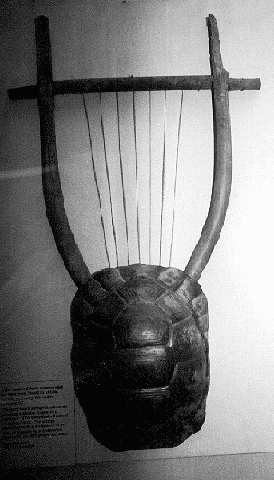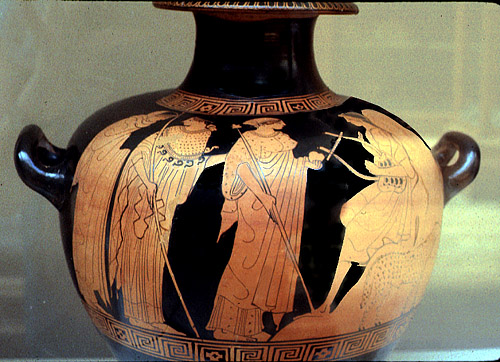Reconstructing the Greek Lyre
The story of Hermes and the first lyre is quite descriptive, and lends itself well to the imagination. According to the myth, Hermes used a grey iron scoop to hollow out the shell of a mountain tortoise, fastened cut stalks of reed across the back, and stretched ox hide across the front (the shell is providing the back here, if you needed a reference). He then plucked the intestine-strings (I simply can't get over that) with a plectrum, or a pick. (Homeric Hymn to Hermes, 31-53) I should mention, too, that I may have been incorrect in my earlier presumption that both the strings and the hide came from the same animal, as sources are in disagreement of whether the intestines were taken from a sheep or a cow.
Knowing this, it's now apparent why we no longer have any actual Greek lyres constructed in this way - considering it was made of mostly organic matter, it's unlikely that any of them would have avoided decomposition (which is a word I love to use in reference to music).
And while that's a bit of a disappointment, I've encountered many artists' depictions of the original lyre. Some, even, attempted to construct what they believed to be an accurate recreation seven-string tortoise-shell lyre using available materials, such as local tortoise-shells (which have been, in almost all cases, either North American or British) and various strings instead of intestine.
However, according to some scholars, these reproductions aren't necessarily accurate. There is a debate on whether the arms of the lute are, as these pictures have shown, flat. Essentially, most lyre enthusiasts believed the lyre to be able to be accurately represented in a 2-d diagram, when it is shown in a few rare 4th and 3rd Century B.C.E. Athenian vases (wherein the lyre is represented in its 3-d form) to have forward-curving arms.




Last 4 photographs Thanks to Martha Mass, Link in Bibliography
 A statue of Apollo kitharoidos and musagetes, Sheepishly borrowed from Wikipedia
A statue of Apollo kitharoidos and musagetes, Sheepishly borrowed from Wikipedia
Now, there is some speculation as to whether or not these curved-arm depictions are errors of perspective on the Greek Artists' part (exemplified by my final source, one of the editors of the American Journal of Archaeology).. But I wonder. The Greeks are certainly not notorious for inaccurate depictions. And (I'm so sorry you don't have access to the photographs yet - I'll update this entry when I get them!) looking at the other pictures, it seems that if it is a matter of perspective, it doesn't carry into the forms of the people or the other instruments.
I think that the curved-arm theory has merit; it would be much more beneficial for a musician to have a curved-armed lyre. Providing the size of the instrument stayed the same, this would alter the distance and tension on the strings, changing the pitch to a lower, more vibrant sound (allowing the string to vibrate in the third dimension uninhibited by the boundaries of the stretcher bars), and it would later lend itself much better to the later Byzantine method of bowing the strings (again, getting the arms out of the way of the strings has its clear advantages!).
I stumbled upon one such recreation, which may help you understand the shape I'm trying to convey:
Oddly, this build did not match the adjacent pictures in the article in regards to the curvature, but if I may be so bold, it seems to me that this is a more insightful design.
To find out the truth, one needs only to look at the artistic recreations.. In a 2-d representation (a vase, for example), a traditionally accepted lyre turned on its side would appear to be a turtle shell with a long, thick line coming out of the side. I haven't scoured every publication on the matter, but I have yet to see anyone playing something that looks like that. Another angle to take into account is that if the lyre were flat when placed on its side, it wouldn't lend itself well to a beautiful composition and would be rather confusing as a flat shape - perhaps Ancient Greek artists skewed the perspective for the sake of the greater composition. After all, according to Edith Hamilton, Greek poets held meter and rhythm in the same (if not greater) esteem than the content of their writings.
Sources:
Reconstructing the Greek Tortoise-Shell Lyre
Author(s): Helen Roberts
Source: World Archaeology, Vol. 12, No. 3, Archaeology and Musical Instruments (Feb., 1981),
pp. 303-312
On the Shape of the Ancient Greek Lyre
Author(s): Martha Maas
Source: The Galpin Society Journal, Vol. 27 (May, 1974), pp. 113-117
Edith Hamilton, The Greek Way
W. W. Norton & Company, 1930 pp. 56
(I'm now referencing what my second reference referenced - I did not find this issue)
Florence,
Regio Mus. Arch. 81947,
in Corpus vasorum antiquorum (CVA)
Italy XIII (Florence II), plates 6o no. 2, 64, and 65;
New York Met. Mus. 37-11-23, in American
Journal of Archaeology XLIII (1939), 2-4.
for Pictures:
http://www.tnellen.com
http://www.billcasselman.com
Knowing this, it's now apparent why we no longer have any actual Greek lyres constructed in this way - considering it was made of mostly organic matter, it's unlikely that any of them would have avoided decomposition (which is a word I love to use in reference to music).
And while that's a bit of a disappointment, I've encountered many artists' depictions of the original lyre. Some, even, attempted to construct what they believed to be an accurate recreation seven-string tortoise-shell lyre using available materials, such as local tortoise-shells (which have been, in almost all cases, either North American or British) and various strings instead of intestine.
However, according to some scholars, these reproductions aren't necessarily accurate. There is a debate on whether the arms of the lute are, as these pictures have shown, flat. Essentially, most lyre enthusiasts believed the lyre to be able to be accurately represented in a 2-d diagram, when it is shown in a few rare 4th and 3rd Century B.C.E. Athenian vases (wherein the lyre is represented in its 3-d form) to have forward-curving arms.




Last 4 photographs Thanks to Martha Mass, Link in Bibliography
 A statue of Apollo kitharoidos and musagetes, Sheepishly borrowed from Wikipedia
A statue of Apollo kitharoidos and musagetes, Sheepishly borrowed from WikipediaI think that the curved-arm theory has merit; it would be much more beneficial for a musician to have a curved-armed lyre. Providing the size of the instrument stayed the same, this would alter the distance and tension on the strings, changing the pitch to a lower, more vibrant sound (allowing the string to vibrate in the third dimension uninhibited by the boundaries of the stretcher bars), and it would later lend itself much better to the later Byzantine method of bowing the strings (again, getting the arms out of the way of the strings has its clear advantages!).
I stumbled upon one such recreation, which may help you understand the shape I'm trying to convey:
Oddly, this build did not match the adjacent pictures in the article in regards to the curvature, but if I may be so bold, it seems to me that this is a more insightful design.
To find out the truth, one needs only to look at the artistic recreations.. In a 2-d representation (a vase, for example), a traditionally accepted lyre turned on its side would appear to be a turtle shell with a long, thick line coming out of the side. I haven't scoured every publication on the matter, but I have yet to see anyone playing something that looks like that. Another angle to take into account is that if the lyre were flat when placed on its side, it wouldn't lend itself well to a beautiful composition and would be rather confusing as a flat shape - perhaps Ancient Greek artists skewed the perspective for the sake of the greater composition. After all, according to Edith Hamilton, Greek poets held meter and rhythm in the same (if not greater) esteem than the content of their writings.
Sources:
Reconstructing the Greek Tortoise-Shell Lyre
Author(s): Helen Roberts
Source: World Archaeology, Vol. 12, No. 3, Archaeology and Musical Instruments (Feb., 1981),
pp. 303-312
On the Shape of the Ancient Greek Lyre
Author(s): Martha Maas
Source: The Galpin Society Journal, Vol. 27 (May, 1974), pp. 113-117
Edith Hamilton, The Greek Way
W. W. Norton & Company, 1930 pp. 56
(I'm now referencing what my second reference referenced - I did not find this issue)
Florence,
Regio Mus. Arch. 81947,
in Corpus vasorum antiquorum (CVA)
Italy XIII (Florence II), plates 6o no. 2, 64, and 65;
New York Met. Mus. 37-11-23, in American
Journal of Archaeology XLIII (1939), 2-4.
for Pictures:
http://www.tnellen.com
http://www.billcasselman.com





No comments:
Post a Comment